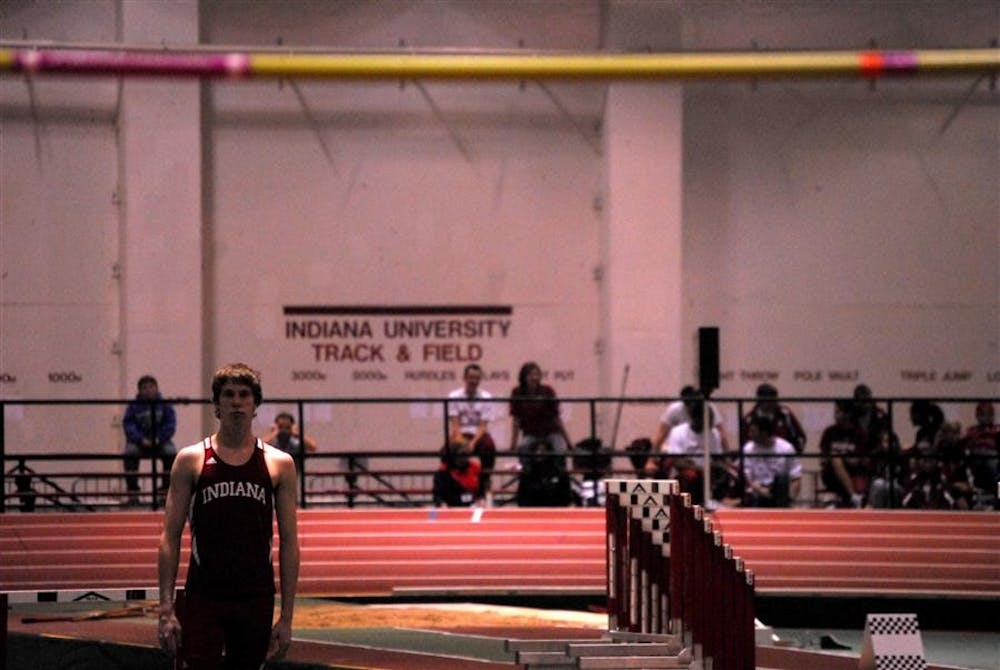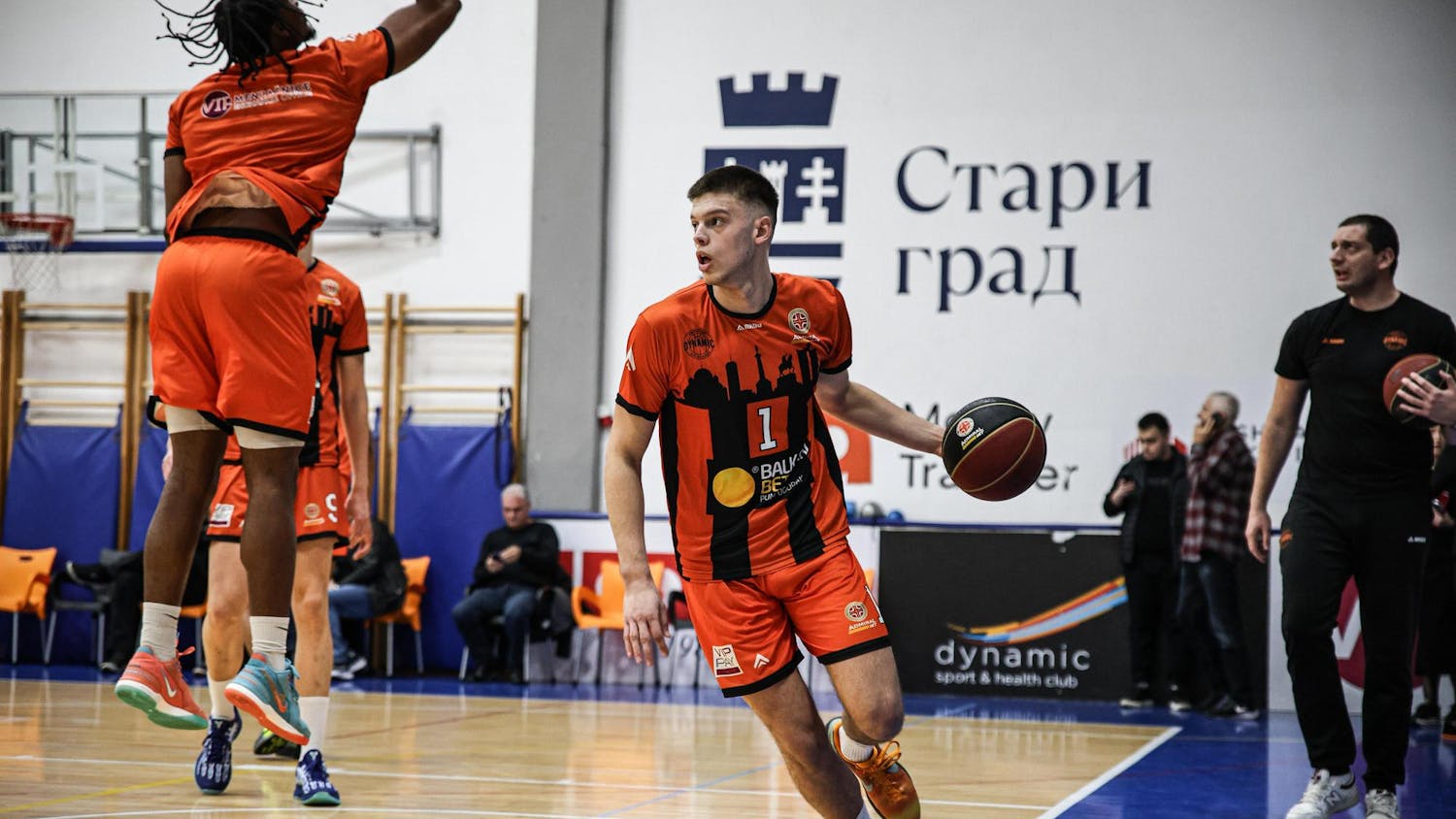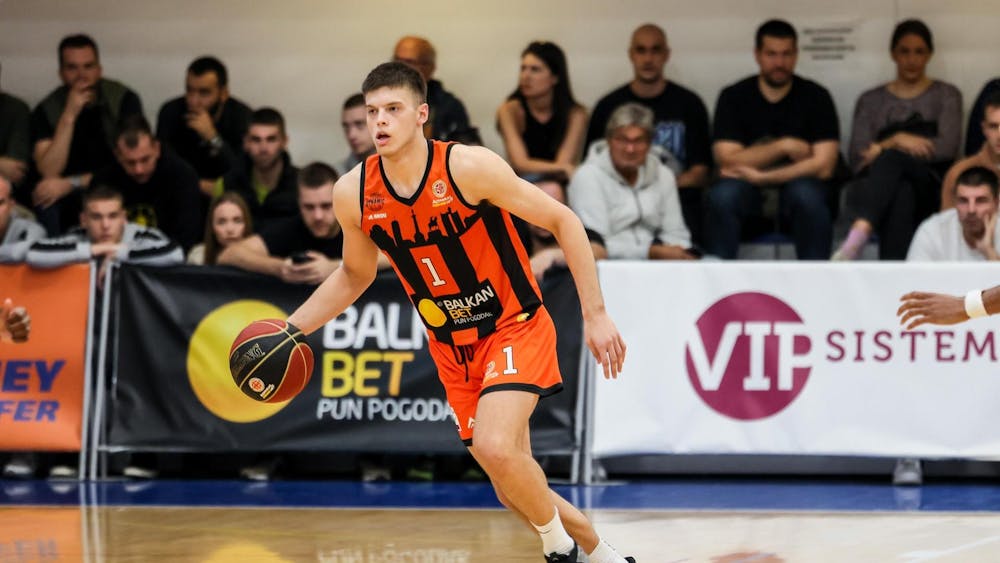The high jumper stands at the top of the lane, motionless for 32 seconds.
He stares toward his nemesis, a bar balanced 2.17 meters above the track – a barrier he is determined to clear. His light blue eyes bore into it as he psyches himself up to run toward his lone obstacle here in Gladstein Fieldhouse, home of the IU track and field team. To him, the rest of the arena has fallen away. All that’s left is him and the bar.
“OK, this isn’t anything,” the young man silently tells himself. “I’m used to it. I’ve seen this height before. I can jump this.”
For the eternity of those 32 seconds, he focuses on one goal. To overcome. To ascend. To defy gravity.
The lane leading to the bar, roughly 15 yards away, is a runway. And Derek Drouin is ready to fly.
---
Drouin, a 19-year-old sophomore, resembles a heron. He is tall – 6-foot-4 – and long and skinny. His build is typical for a high jumper.
IU assistant coach Jeff Huntoon describes Drouin as a “prototypical” high jumper. But Drouin’s body is not his only weapon. He also possesses the mental edge that defines the elite group of athletes who glide above the bar. He and Ashley Rhoades, a high jumper for the IU women’s team, have reached new heights this year based on their almost supernatural ability to envelop themselves in concentration.
“Both of them have the ability to focus in on what they’re doing and not get lost in a lot of the other minutiae that’s going on around them and not get caught up in too many other thought processes,” Huntoon says. “They’re going to focus on the one or two little elements that allowed them to miss the last bar and just go out there and give another good attempt.”
Drouin, a native of Canada, first tried jumping in grade school, but didn’t really start competitively until he reached his junior year of high school in 2007. That same year, he went to the World Youth Championships in the Czech Republic. The pressure of the international spotlight did not stop him from performing, as he earned a 10th place finish.
“Really, getting thrown into the deep end, I just learned to swim,” he says.
---
On this Saturday, as the seconds tick away, Drouin won’t be hurried. He is waiting for a feeling of readiness. He can’t describe it, but he’ll know it when it comes.
Around him, the arena bursts with distractions. Fans are clapping for a pole vaulter attempting a personal record. A triple jumper sprints toward a sandy pit, his legs pounding the clay. Drouin hears none of it. Although his team is technically competing against their rival squad from Purdue University, Drouin recognizes that the bar is his true opponent. At its current height, it stands more than half a foot above his head. No one else from his team or Purdue’s has been able to clear it today.
“I’ve been doing it for a while, and I’ve actually taught myself just to concentrate so much on the bar that I can’t really hear anything else,” Drouin says. “It’s just something you have to teach yourself how to do.”
On his first leap of the day, a routine jump of 2.14 meters, he cut his wrist on the mat that breaks the jumpers’ falls. Even though the wound is still bleeding, he must force the lingering pain out of his mind. Any distraction could spell disaster.
The bar is unforgiving. The slightest touch, and it falls. Drouin’s current jump is only three centimeters higher than the last. But in this sport, even the slightest increase in height exponentially increases difficulty – and the jumper’s doubts. Sooner or later, as the bar is raised higher and higher, even the most gifted flyers crash.
“High jump and pole vault are the only two events that end in failure,” says Jared Nuxoll, another IU high jumper. “Your last three attempts are always going to be misses. It’s important to stay positive.”
The bar radiates uncertainty, especially when jumpers attempt personal records. Once it is set, Nuxoll says, a daunting thought creeps into the jumper’s mind: “I’ve never jumped higher than that.”
Form fails. Even the best mentally crumble. And as confidence fades, so does the chance of succeeding.
When Drouin’s about to head down the runway, he has to erase his doubts and overcome his fear. Sometimes he will take his first few steps and already know he’s off to a bad start. Even then, there’s no turning back.
This afternoon, as Drouin gathers himself at the top of the lane, something slowly shifts inside him. His eyes become glassy. The tension in his body evaporates. He enters his own world.
With his right leg positioned in front of his left, he rears back just a little, then propels himself forward and starts to run.
---
Jumping is an emotionally charged event, and every jumper handles it differently.
In the 2009 NCAA Mideast Regional, Drouin was pitted against an indoor national champion in the long jump and All-American in the high jump, Tone Belt of the University of Louisville. Belt was hungry for another victory, and his voracity knew no bounds. Drouin was his main competition, and he knew it. With every jump he completed, Belt unleashed a primal roar and stared at Drouin to make sure the freshman was watching.
Drouin was not intimidated. As the day wore on and the stakes climbed, he stuck to his routine. Every time he finished a jump, he avoided celebration. His unshakeable cool won him respect from his peers and a first-place finish.
This year, Drouin has been flying higher than ever. In the inaugural event of the season, the Indiana Open, he cleared 2.24 meters, earning automatic qualification to the NCAA Indoor Championships in March. But he didn’t stop there. The next height he attempted was 2.28 meters – a mark that would have won him the best clearance of the indoor season. Not just collegiately. Not just nationally. But in the world.
His first and second attempts were close – so close that on the second try, he thought he’d made it. As he landed, the bar remained in place for a split second, then fell. When it collapsed, so did he.
“I was already on the mat, and I thought I’d made it,” he says. “I heard everyone sigh, and then I realized that I’d missed it. I’ve seen video, and I’m still not really sure of what hit the bar.”
That day, Drouin had earned the best clearance in the nation in the high jump. His jump bested that of any amateur or professional, even Olympic hopefuls. And still, the bar had won. This is the elemental struggle all high jumpers face. Because the bar always triumphs in the end, it inspires fear of failure and defeat. And that fear costs jumpers dearly.
But Ashley Rhoades, also one of the country’s best collegiate high jumpers, says the bar also embodies something other than doubt. To her, it symbolizes possibility.
“It just motivates me that there’s always another mark,” she says. “There’s always another goal that I can reach. If it’s a centimeter, if it’s a couple inches, there’s always a little bit better that you can do. There’s always another standard that you can hit.”
To her, the possibilities are more powerful. Achieving a goal, breaking a record. Soaring above it all.
---
It took Drouin 32 seconds to collect himself. Now, accelerating down the runway, it only takes him four seconds to approach his target.
As he gets closer, he repeats the same thought over and over.
“I can still do it . . . I can still do it . . . I . . . ”
At the last moment, he curls toward the right, so that the left side of his body is parallel to the bar. He throws his arms back, bends his knees and goes airborne. He sails head first, his back facing downward. As his butt clears the bar, he kicks his legs toward the sky. Even before he lands, he knows he’s made it.
What no one else has accomplished today, he makes look easy. He would like to jump up and down, but all the energy inside him is drained.
He stands up, his face set in stone. Without a word, he walks away.
IU high jumper learns to fly

Get stories like this in your inbox
Subscribe





